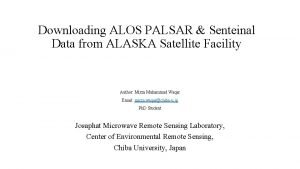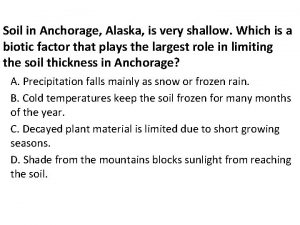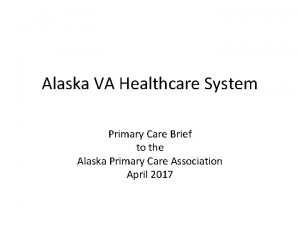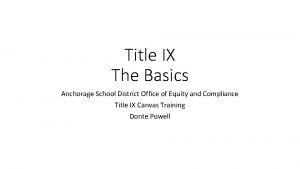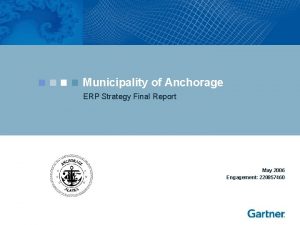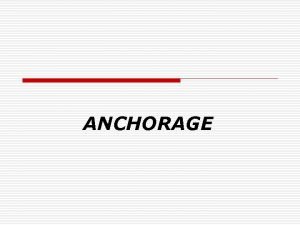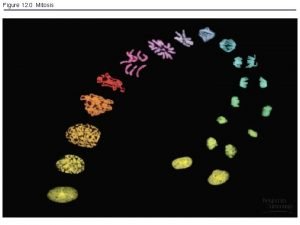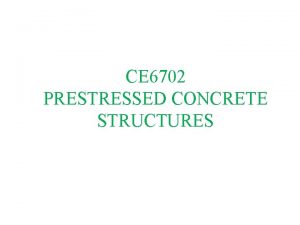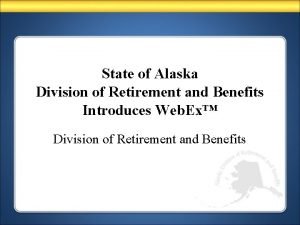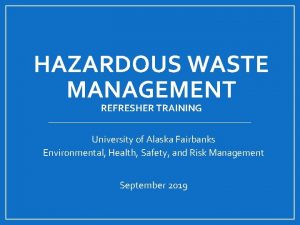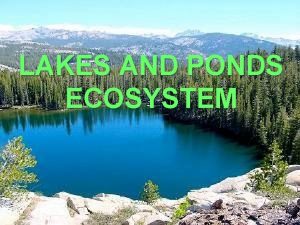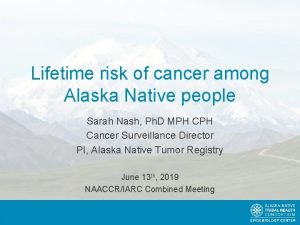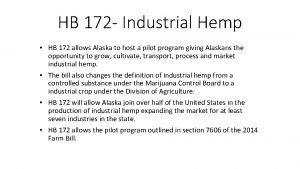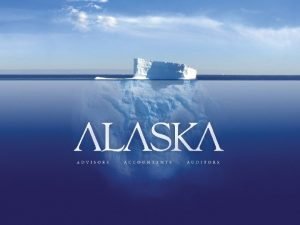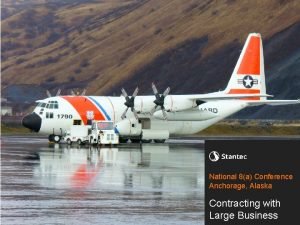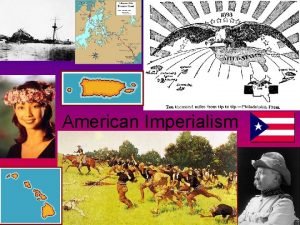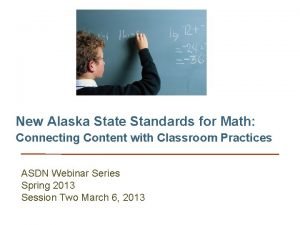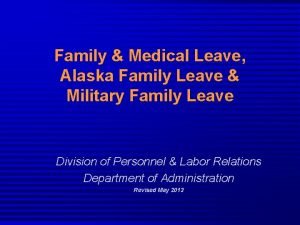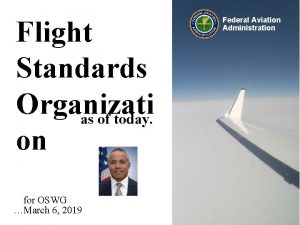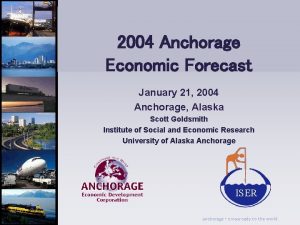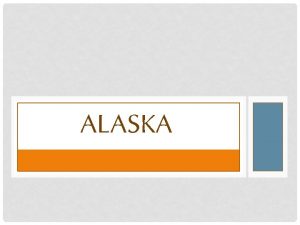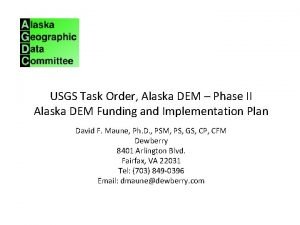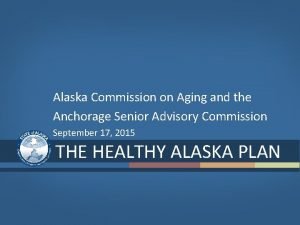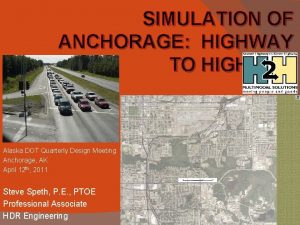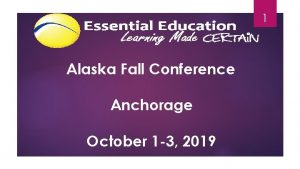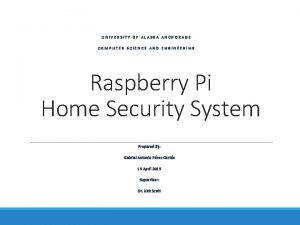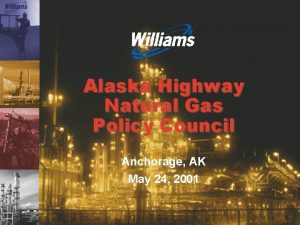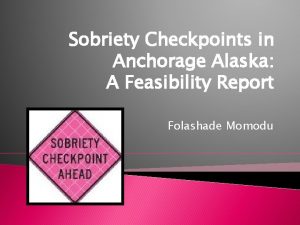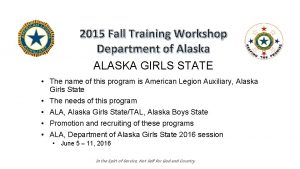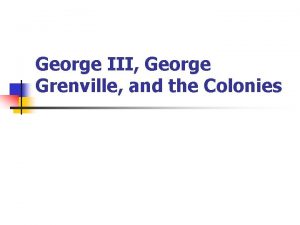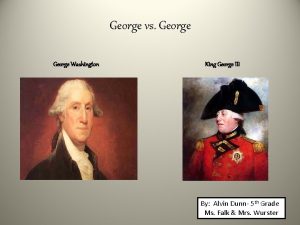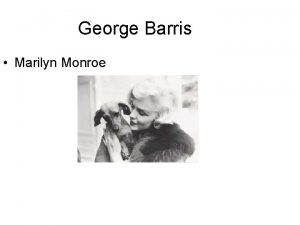Alaska DEM Workshop George Y G Lee Anchorage







































- Slides: 39

Alaska DEM Workshop George Y. G. Lee Anchorage, Alaska July 2008

Outline Why elevation is important to USGS National Digital Elevation Program (NDEP) The National Map and elevation data Lidar activities and Lidar for the Nation Alaska requirements and National Elevation Plan 2

Importance of Elevation Data to the Nation USGS responsibility as A-16 data category Value of nationally, consistent elevation data set Importance to the Digital Orthophoto Program, including Urban Area data for Homeland security Importance of elevation data to the commercial satellite companies Importance of higher resolution elevation data to USGS science programs, especially climate change studies 3

USGS Data Requirements A-16 responsibilities (hydro, elevation, orthoimagery, and names) The National Map needs Other USGS Discipline missions (Geology, Water Resources, BRD) Science Program (i. e. , climate change) 4

USGS Elevation Data Acquisition Ancient past (completion of 1: 24 K series and DOQ first coverage) Recent past (10 -meter DEM partners) Current priorities (Hazards, 10 -meter partners, Urban Areas) Future priorities (data maintenance, hi-res DOQs, other agency needs and partnerships, emergency response, and science programs) 5

NDEP Established to promote the exchange of accurate digital land elevation data among government, private, and non-profit sectors and the academic community and to establish standards and guidance that will benefit all users Federal (11 agencies), State (NSGIC Rep) Open Invitation to participate Organization - Steering Committee, Technical Subcommittee, Project Coordination Subcommittee 6

National Digital Elevation Program BLM FEMA USFWS NOAA NGA NASA NSGIC www. ndep. gov NRCS USACE US Census USFS USGS A consortium of agencies coordinating the collection and application of high-resolution, high-accuracy elevation data 7

NDEP Goals Enhance data sharing among Federal, State, and local agencies; the private sector; and academia Minimize redundant data production Leverage resources to satisfy multiple requirements Develop flexible standards that meet the needs of most users Ensure the availability and accuracy of digital topographic data 8

Technical Subcommittee Dean Gesch, USGS Forum for information exchange Standards development Technology assessment 9

Standards Development USGS 30 -meter DEM standard Guidelines for digital elevation data – best practices Inventory of agency-specifications and standards l l USGS FEMA NOAA Others Framework Elevation Standard ASPRS Lidar Guidelines 10

Project Coordination Subcommittee Bryon Ellingson, USGS Project Tracking System http: //hazards. fema. gov/metadata/NDEP/ Project Information Form Minimal Elevation Specific Metadata set Viewer View w/ Query tools GOS Harvestable (supports Module 3), Link with RAMONA and FEMA MIP activity 11

NDEP Project Tracking 12

ROMONA FEMA supported, Paul Rooney NSGIC pockets of interest Is it being used? Why and why not? 13

14

NDEP Mode of Operation Signed Charter NDEP Organizational Structure, Chairperson, Executive Secretary Meetings and telecons Public website update and maintenance Quickplace website for internal communications 15

New Directions for NDEP Focus on coordinated elevation data acquisition and maintenance of a national database Support new budget initiatives Develop National Elevation Plan 16

USGS Research and Applications Activities Limited basic research Limited applications within Geography and GIO Limited multi-discipline cooperative research Limited development and testing with Corp of Engineers Research primarily in support of data acquisition, derivative products, and production systems development Accuracy and comparison of new acquisition methods No other recall of any cooperative research with other agencies 17

Agency Issues and Concerns Lack of data maintenance program Not meeting needs of other Federal agencies Lack of National Elevation Program Plan Lack of adequate funding Licensed data model Lack of quality assurance guidelines for sensors and data acquisition 18

The Nation Map • Elevation • Geographic Names • Hydrography • Land Cover • Orthoimagery • Boundaries (Government Units) • Structures • Transportation 19

Vintage of Elevation Data Age of USGS topographic maps in the National Elevation Dataset (NED) • Terrain data in USGS topographic maps are on average 35 years old 20

Multi-Resolution NED 1 arc second 1/3 arc second 1/9 arc second

Feature Extraction: • B 22

23

24

The National Map Needs: • The National Map needs higher resolution elevation data • The National Map needs up-to-date elevation data • The National Map needs lidar data to map other map category features • Not “Lidar for the Nation” but rather “National Elevation Program” 25

National Lidar Mapping Initiative: A Medium-Altitude Advanced-Technology Implementation Concept David J. Harding NASA Goddard Space Flight Center david. j. harding@nasa. gov 26

National Academy of Sciences Recommendations: FEMA Floodplain Mapping & Earth Sciences Decadal Survey Two NRC Committee Reports Issued in January, 2007 Floodplain Mapping Technologies Commissioned by Congress to Advise FEMA Elevation for the Nationwide, seamless, consistent, publicdomain, elevation data set created using airborne laser swath mapping (ALSM) Contours: 1 ft (low relief), 4 ft (high relief) Update 10 m & 30 m NED Earth Science and Applications from Space to Advise NASA, NOAA and USGS LIDAR Surface Topography (LIST) Global topo & vegetation structure 5 m spatial resolution 0. 1 m vertical precision for ground Launch time frame: 2016 -2020 Update 30 m & 90 m SRTM 27

A Wealth of Information Derived from Lidar Volcano Monitoring Carbon / Biomass State-wide lidar mapping completed or in progress Land Cover Earthquake Faults Hydrologic / Hydraulic Urban Response Coastal Inundation Wildland Fires 28

Approaches to Accomplish National Lidar Mapping Invest to Advance Capabilities Utilize Existing Capabilities ± Low Altitude (1 to 2 km) Imposing Narrow Swath (~ 1 km) Local (<20 km) Kinematic GPS INS+GPS Attitude (0. 01°) Single Beam and Detector Incomplete Reference Frame Ad Hoc Error Analysis Current Geoid for Ortho Heights High Altitude (e. g. 15 km) Enabling Wide Swath (e. g. 10 km) Regional (e. g. 1, 000 km) PPP GPS INS+Star. Camera Attitude (0. 001°) Multiple Beams and Detectors Rigorous Reference Frame Systematic Error Analysis Concurrent Aerograv for Better Geoid 29

Potential Scenarios to Accomplish National Lidar Mapping Increasing Role for Advanced Capability Scenario 1: compete coverage by existing capability no use of advanced capability Scenario 2: complete coverage by existing capability continental datum tie-lines using advanced capability Scenario 3: logistically easier areas mapped by existing capability logistically challenging areas mapped by advanced capability Scenario 4: Conterminous U. S. mapped by existing capability Alaska mapped by advanced capability Scenario 5: local high-resolution mapping by existing capability complete coverage by advanced technology capability 30

Decision Factors for National Lidar Mapping + The selection of an implementation scenario should be driven by which maximizes total benefit for the nation: Quality and uniformity of the resulting data and products Time-frame over which the job is completed Cost to complete the job Capabilities and infrastructure established while doing the job Advancement of the U. S. mapping and remote sensing industries Suitability for continued mapping for change detection and map updating 31

National Lidar Mapping Initiative Concept: Potential Partner Roles USGS: • project leadership and management Local, state and federal agencies: • requirements and standards for lidar data & DEM products meeting their mandates NASA: • integrate and test medium-altitude airborne lidar instrumentation • implement data processing methods & infrastructure • provide instrumentation and infrastructure for operation by commercial sector Commercial Sector: • acquire and process medium-altitude, nation-wide data • acquire and process low-altitude, higher-resolution data for high-priority areas and for QC/QA • produce derived parameters using classification & feature extraction procedures • produce DEM products TINs, DSMs, DTMs, canopy structure, building shapefiles • create and market value added products NASA and USGS: • QA raw data, derived parameters and DEM products USGS: • archive and distribute raw data, derived parameters and DEM products Local, state and federal agencies: • use derived parameters, DEM products & value added products to meet their mandates 32

Partners interested in National Coverage The concept of a national Lidar survey was explored at a September 2006 meeting NASA, USGS, NOAA, Association of American State Geologists NASA, USGS, USACE, NOAA, NGA, FEMA, NRCS, Forest Service, and other Federal agencies already collect Lidar data Growing interest in a full return Lidar baseline dataset for the nation to meet multiple requirements 33

Next Steps for the Lidar Effort Establish USGS Advisory Committee Define strategy Provide periodic review Invite other agency participation Define requirements Propose national program plan Define specifications 34

Proposed FY 2010 Budget Good news is: $$ M for mapping and integration Includes $ M for Liar Bad news is: Mapping is only part of $$$ M over target initiatives within DOI 35

Need for a National Elevation Plan Geo. LOB Bureau Data Resource (data call): Impact on Federal agencies A-16 Performance Reporting for National Spatial Data Infrastructure Data Themes Lidar for the Nation (Background, Workshop Summary, Future Plans) Development of National Elevation Plan 36

Summary Alaska needs good elevation data Alaska needs DOQs Alaska seems to be neglected Alaska IS different Not a single solution Complex project management and QA issues Alaska elevation needs should be a part of the National Elevation Plan Public domain is still a general requirement 37

Thanks Questions? ? ? 38

Contact information: George Lee, 650 -329 -4255, gylee@usgs. gov 39
 Vertex alos palsar
Vertex alos palsar The finest grained soils are richest in
The finest grained soils are richest in Va hospitals in alaska
Va hospitals in alaska Anchorage school district office
Anchorage school district office Tension anchorage length
Tension anchorage length Insulfoam mead ne
Insulfoam mead ne Practical design to eurocode 2
Practical design to eurocode 2 Municipality of anchorage procurement
Municipality of anchorage procurement Anchorage
Anchorage Job center anchorage
Job center anchorage Intermaxillary anchorage
Intermaxillary anchorage Female karyotype
Female karyotype Prestressing a concrete beam with sloping or curved cables
Prestressing a concrete beam with sloping or curved cables Bicortical implant
Bicortical implant Anchorage rotary
Anchorage rotary George gray by edgar lee masters
George gray by edgar lee masters George washington vs king george iii venn diagram
George washington vs king george iii venn diagram Venn diagram ghent
Venn diagram ghent Alaska division of retirement and benefits
Alaska division of retirement and benefits Alaska easternmost state
Alaska easternmost state Hazmat training alaska
Hazmat training alaska Lakes and ponds ecosystem
Lakes and ponds ecosystem Alaska purchased from canada
Alaska purchased from canada Alaska cancer registry
Alaska cancer registry Alaska hb 172
Alaska hb 172 Friendly floatees
Friendly floatees Alaska boekhouding
Alaska boekhouding National 8a conference alaska
National 8a conference alaska Denali oncology group alaska
Denali oncology group alaska Evan ramsey alaska
Evan ramsey alaska Russia wants alska
Russia wants alska Acpe student loan
Acpe student loan What is the proper adjective for alaska
What is the proper adjective for alaska Alaska state standards math
Alaska state standards math State of ak retirement
State of ak retirement Alaska family medical leave act
Alaska family medical leave act Uaf bookstore textbooks
Uaf bookstore textbooks Fifty nifty united states from thirteen original colonies
Fifty nifty united states from thirteen original colonies Alaska posizione geografica
Alaska posizione geografica Rick domingo alaska airlines
Rick domingo alaska airlines
